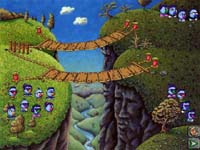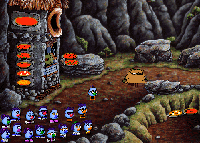





|
Sample Dialogue from
Logical Journey of the Zoombinis
Image © the Learning Company. Used with permission.

Puzzle: Allergic Cliffs, Level 1
Players get six chances to get all 16 Zoombinis across a chasm. Each Zoombini can go over only one of the two bridges. Zoombinis who are placed on the incorrect bridge are sneezed back by the Cliffs (this also removes one of the six pegs holding the bridges in place). Solving this puzzle is like playing Guess My Rule - on Level 1 the game sorts the Zoombinis according to one characteristic -- for example, all the Zoombinis with sunglasses go across the bottom bridge; the rest (one-eyed, two open eyes, regular glasses, and droopy eyes) go across the top bridge.
R. and C. are both third grade boys. R. has played Zoombinis twice previously; this is C's first time with the game. R. is explaining the game to C as they enter Level 1 with 8 pairs of "twin" Zoombinis. The total time of this clip represents about 1 minute and 45 seconds.
Dialogue
R explains the game to C. He articulates the goal of the puzzle (to get the Zoombinis across the bridge by seeing which Zoombini the bridges will take) as well as a strategy for doing so: once you get a Zoombini across, its twin will follow over the same bridge.
--R: This is a hard one. You have to see which one they'll take. And if they take this, then put the other twin... right here. Think that's where, cause they sneeze. (pointing to cliffs beneath the bridges)
--R: You think she should go there? You think... (R. sees and hears the cliff beginning to sneeze.) Oh man!
--Game: Ahhh choo!
--R: Just put her over here and put the same twin right there over there. No, right up, right there. ... Now put her there. We shoulda made all of them twins. That way all of them could go up here and all the girls, look just like that.
R. continues to develop his theories on using "twins." R. also develops categories of Zoombinis unrecognized by the game, such as girls here and geeks, below. However, even when developing categories that are not recognized by the game, R. is thinking about categories, attributes, and strategies for sorting -- the mathematical emphases of this puzzle.
--R: Put that geek up there. Put the... Even though he's not a geek but at least he's still the same kind. (beginning of a sneeze) What?!
--Game: Ahhh choo!
--C. looks to R. and laughs at the rejection.
--R: I just wish they could make it! Ok we have 1, 2, 3, 4, 5, 6, 7...
--C: They look alike.
--R: (points) Please please please... Do they have the same color nose? Put him over here (pointing).
--C: Yes.
--R: Just have a little [Zoombinis] left [to get across]... Now I hope they go in the right places.
--C: Oh she did it too!
Here we see evidence of further strategy, as R. puts Zoombinis of "the same kind" on one bridge. He is surprised when that Zoombini is rejected. C. is amused by the narrative aspects of this puzzle, as is R., who is also worried about getting all the Zoombinis across safely. He counts how many are across and pleads with the prone-to-sneezing mountains to let more by. He also introduces a new idea in terms of strategy, focusing on one particular trait nose color.
Image © the Learning Company. Used with permission.

Puzzle: Pizza Pass, Level 1
Arno, the pizza troll, is hungry and wants you to make him a pizza. Players top a plain pizza with any of the toppings available to them (olives, peppers, pepperoni, mushrooms, cheese) in an effort to make the particular pizza he wants. A Zoombini presents each pizza to Arno, who gives feedback about his preferences by throwing pizzas into the pit ("Something on that I don't like," "Something must go!" and "Eeeew, yuck!") or onto his rock ("More toppings!" or "C'mon, more stuff."). After the sixth incorrect try, the Zoombini presenting the pizza gets a warning hit. After the seventh incorrect guess, the Zoombini gets knocked out of the puzzle, and goes back to wait for the others at Zoombini Isle. Each incorrect guess from then on out loses a Zoombini.
C. and E. are both third grade girls. This is E's second time playing Zoombinis and C's fifth. It is their first time playing together. They are about to enter the pizza puzzle with 16 Zoombinis. This clips represents less than 3 minutes of play.
Dialogue
C. recalls the particular pizza that worked last time and thinks they should begin by trying that. E. agrees and chooses the toppings suggested, but also realizes that the troll changes his preferences each time you visit.
--C: Oh! Last time we did it I think it was this this and that.
--Game: Whatever you are, make me a pizza!
--E: (with mouse) This?
--C: This ... meatballs (E: This?) thing. Yeah. And that. (E: And that?) Yeah.
--E: Oh he changes it. It could be anything.
They try: cheese, meatballs and sausage.
--Game: Something on that I don't like.
--C: All right.
O. looks over from another computer.
--O: Guys... (He comes over, and stands next to E.) Try onions, that and that.
--C: That's all?
--E: What are onions?
--O: The green things. (He's back to his seat.) C. points and E. clicks. "That that and that."
Again, C. and E. are willing to try a 'proven' pizza, one that worked on O's game. However, E. then begins collecting data checking the pit of rejected pizzas to see what they have already tried in an effort to eliminate the topping(s) Arno doesn't like. ... Later in the same play session, the girls haven't made much more progress and both children are getting frustrated. C. goes off in search of help in the form of F., a known Zoombini expert. F. continues to reinforce the idea that the troll wants something different every time. Although they try the solution F. provides, E analyzes the toppings on it, realizing she has already eliminated one of them.
--C: F? ... What did you do for beating the pizza?
--F: It's not the same every time though.
--C: I know but what did you do, it might work? What did you do? (Brings F. over.) Listen to F. She beat it.
--F: All four the last ones. (E: What?) The last four.
--E: This that that and that? (F: The last four on the list.) This that that and that?
--C: F! F! (pointing) This that and that and that? (F: Mm hmm.)
--E: But he doesn't like these.
--F: Well that's what it was on mine.
C. and E. are clearly quite frustrated. However their engagement with the narrative of the game (there was much interaction with, protection of and imitation of characters in other portions of the play session) as well as with the puzzle, keeps them persisting. Note that the structure of the game (no time pressure or final death) allows them many attempts, time for discussion, and the opportunity to ask for help.

Back to the top of the page
|


